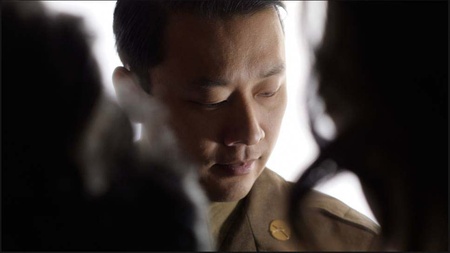In Kerwin Berk’s short film, Kikan: The Homecoming the most dramatic moments occur around a dining room table when no one is speaking. The Ito family, trying to absorb the loss of their only son Ken (Ken Takeda) at the end of the war in Europe, is confronted with the reality of his death when a fellow 442nd Regimental Combat Team veteran Jimmy Ibata (Ryan Takemiya) unexpectedly shows up at their home in San Francisco.
As the film depicts, Ken’s dying wish is that Jimmy return an heirloom: a pocket watch. It is a request that Jimmy tries desperately to deflect and deny, but cannot avoid as the inevitable transpires. His despair at not being able to save Ken, who he has just met, is amplified when Jimmy learns from another 442nd member (Kealoha Nakamura) that the war had actually officially ended three days earlier.

Burdened with his own physical and emotional wounds, Jimmy sits silently around the table with Ken’s parents (played by Roji Oyama and Miyoko Sakatani), sister Wendy (Anna Sun), and grandmother (Chizu Omori) as the pocket watch ponderously ticks off the time. Even a specially prepared meal does not alleviate the tension created by the awkward meeting of the soldier who survived with the family of the soldier who died.

As with the dining room scene, so much of the drama of Kikan is embedded in the audience’s understanding of the context of this story. While a viewer unfamiliar with the Japanese American World War II experience could appreciate the film and the fine performances by the cast, those who know the history of the community’s forced removal and unlawful mass incarceration in concentration camps and the sacrifices of the 100th Infantry Battalion/442nd R.C.T. and Military Intelligence Service will feel the characters’ pain and dilemma more deeply.
In fact, Berk, who directed and wrote the script, deliberately crafted his film for the latter audience. “Our (Ikeibi) production company is all Asian American,” he explained. “Our audience is other Asian Americans. We kind of made the film for ourselves.”
Almost all of the cast have family ties to the camps and/or the 442nd. Takemiya, for example, noted that his father Fred’s uncle served in the 442nd and his grandfather was held in Manzanar. “I was very aware of the story,” Ryan said. “Got bits and pieces from my own family. I was very excited to be in this project.”
Both Berk and Takemiya were hoping the film will help to humanize the Japanese American soldiers, who have been rightly honored by their community and country. By conveying an unblemished hero-status to them, however, their actual suffering from post-traumatic stress disorder and other ailments is often overlooked or minimized.
Takemiya noted that Jimmy uses his sarcastic wit as a defense mechanism. “I appreciated the humor of the character,” he revealed. “The Nisei in my own family liked to crack jokes. I wanted to play a 442nd character as a regular guy.”
Berk explained that because so many of the cast and crew had their own personal ties to the history, “Everyone could chime in about their own experiences and add to the story.”
The attention to detail is important to Berk, who grew up in the Bay Area with a Nisei mother and Japanese grandfather. After attending the University of Texas, he worked for two decades as an award-winning journalist, writing for newspapers in Texas and San Francisco and overseas. He still works as a freelance writer, but has branched out into filmmaking with such works as The Virtues of Corned Beef Hash, Infinity & Chashu Ramen, and Gold Mountain.
The transition from journalism to films wasn’t that big of a jump, he explained, because “the basis of telling the story is still the same.”
In laying out this story, Berk was able to draw upon his many interviews and conversations with individuals of the Japanese American community. It was helpful to the actors that Omori, who helped make the documentary Rabbit in the Moon with her sister Emiko, and who lived through the war, could be consulted on her family’s experiences. Sun, who plays Wendy, had lunch with Omori and Berk to deepen her understanding of the daughter’s character.
Berk also cast the late activist, playwright and poet Hiroshi Kashiwagi to portray the elderly Jimmy in the film’s epilogue. Besides dealing with the family heirloom, this episode suggests a continuation of the family and its connection to San Francisco’s Nihonmachi.
Kikan proceeds at an almost a leisurely pace that reminds me of baseball, a sport that the elder Jimmy follows daily. Today, many complain that a baseball game is too slow. But it is only slow to observers who don’t care who wins or loses the game. With a rooting interest, every play, every pitch, every foul ball has meaning, because it could decide the game.
Similarly, the backstories for the Ito and Ibata families have great meaning for viewers with a rooting interest. Both have suffered the loss of loved ones and property and all have been cast adrift by an indifferent or even hostile government and society. Jimmy, who winds up socially coerced to have dinner with the Ito family and then to spend the night in their home, addresses these questions with Wendy on the stoop when both cannot sleep.
When it’s clear that Jimmy, who has no immediate family, doesn’t know what he will do with his life, Wendy explains that veterans are eligible for the new GI Bill, which pays for college tuition. Jimmy pauses and asks, “Does that mean us?”

To me, this is the extraordinary value of pieces of fiction like this. Having worked at the Japanese American National Museum for many years, I realized that our community’s neglected history first needed to be researched and recorded in books and programs and documentaries. But our history also needed to be examined and explored through art in order to better understand the emotional stories of our families, who often repressed or downplayed the trauma they endured.
“Talking to the soldiers,” Berk observed, “there is a little bit of disconnect to their own experiences. There is often no emotional connection. To get the individual stories, you have to talk to the vets over a long period.”
Once I finally understood the facts of what happened to my own family, I longed to grasp what they were feeling in the moment and how they managed to persevere and rebuild their lives. My parents, like many Nisei, never shared their emotional trauma with their children (although my mother did tell a BBC reporter that her first day in camp with her four-month-old baby, my brother Ralph, was “the saddest day of my life”).
Kikan manages to touch on both of these issues. Jimmy’s voicing of his simple question provides the foundation of the emotional dilemma that our families undoubtedly faced during and after the war when searching for their place in America: “Does that mean us?” Wendy, as the sister and daughter thrust into the leadership role for her family with the loss of their business and home and the death of her brother, creates the impetus to rebuild through her sheer will.
Ultimately, Berk hopes he can rustle up enough support to turn his short film into a longer piece with the title, “Kintsukuroi”, which he explained “roughly translates into ‘finding the beauty in something that is broken.’ It is the Japanese concept that a broken piece of ceramic can be mended, often with gold.”
The film, which Berk said was made mainly through volunteer work by the cast and crew, was produced by Kealani Kitaura with Berk, Kitaura and Ben Arikawa as executive producers. For more information on Kikan: The Homecoming and Ikeibi Films, go here>>.
Kikan: The Homecoming will be screened on Saturday, October 2, 2021, beginning at 2 p.m. in the Tateuchi Democracy Forum at the Japanese American National Museum in Little Tokyo. Filmmaker Kerwin Berk and Director of Photography Ben Arikawa will join cast members Ryan Takemiya, Anna Sun and Kealoha Nakamura in a post-screening discussion.
For more information or to purchase tickets, here >>
© 2021 Chris Komai







